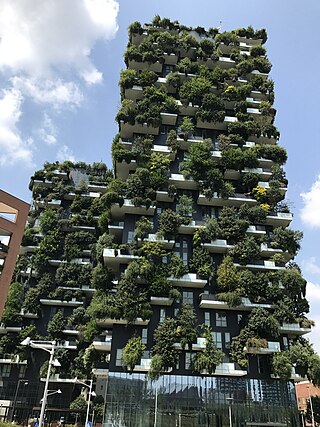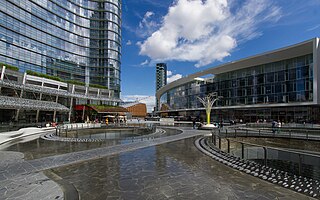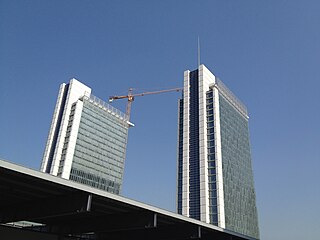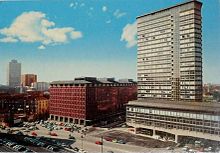
Milano Centrale is the main railway station of the city of Milan, Italy, and is the second railway station in Italy for passenger flow and the largest railway station in Europe by volume.

Milan has an extensive internal transport network and is also an important transportation node in Italy, being one of the country's biggest hubs for air, rail and road networks. Internal public transport network includes the Metro, the Suburban Railway, the tram and bus network, as well as taxi, car and bike sharing services.

The Milan Metro is the rapid transit system serving Milan, Italy, operated by Azienda Trasporti Milanesi. The network consists of 5 lines with a total network length of 104.1 kilometres (64.7 mi), and a total of 113 stations, mostly underground. It has a daily ridership of about 1.4 million on weekdays. The Milan Metro is the largest system in Italy for length, number of stations and ridership; and the seventh longest in the European Union.

The Centro direzionale is a business district in Naples, Italy close to the Napoli Centrale railway station. Designed by the Japanese architect Kenzō Tange, the entire complex was completed in 1995. It is the first cluster of skyscrapers to have been built in Italy or southern Europe.

Milano Porta Garibaldi is a major railway station in the Italian city of Milan, located just to the north of the neighbourhood known as Porta Garibaldi. Porta Garibaldi is the city's main station for commuter traffic with 25 million passengers annually, although it is second to Centrale station considering total passenger traffic. The station is located on Piazza Sigmund Freud.

Garibaldi FS is a station on Lines 2 and 5 of the Milan Metro, and the Milan Passante railway. The Line 2 station was opened on 21 July 1971 as part of the extension from Centrale. It served as the western terminus until 3 March 1978, when the first trains could travel the new route to Cadorna. The Passante station was opened in 1997, and the Line 5 station in 2005.

Verbania-Pallanza railway station serves the city and comune of Verbania, in the Piedmont region, northwestern Italy. Opened in 1905, it forms part of the Milan–Domodossola railway.

Como San Giovanni railway station is the main station serving the city and comune of Como, in the region of Lombardy, northern Italy. Opened in 1875, it forms part of the Milan–Chiasso railway, and is also a terminus of the Como–Lecco railway, which branches off the main line a few kilometres (miles) to the south, at Albate-Camerlata.

Lodi railway station serves the city and comune of Lodi, in the region of Lombardy, northern Italy. Launched 1861, it lies along the Milan–Bologna railway.

The Zone 2 of Milan, since 2016 officially Municipality 2 of Milan, is one of the 9 administrative divisions of Milan, Italy.

Centrale FS is a station on Lines 2 and 3 of the Milan Metro in Milan, Italy. The Line 2 station was opened on 27 April 1970 as a one-station extension from Caiazzo. On 21 July 1971, the line was extended to Garibaldi FS. The Line 3 station was opened on 1 May 1990 as part of the inaugural section of the line between Duomo and Centrale. Initially, Duomo was connected with Centrale by shuttle service, and on 16 December 1990, with the extension of the line to Porta Romana, full-scale service started. The station remained the terminus of Line 3 until 12 May 1991, when Sondrio was opened.
Milano Lambrate railway station is one of the main stations serving the city and comune of Milan, Italy.

Milano Greco Pirelli railway station is one of the main stations serving the comune of Milan. Opened in 1914, it is in the north of the city, in the quartiere of Greco. It is on the Milan–Monza railway.

The Galfa Building or Galfa Tower is a skyscraper in Milan, Italy, located in the Centro Direzionale di Milano district, north of the city centre. It was designed by architect Melchiorre Bega in 1956 and completed in 1959. The name "Galfa" is a portmanteau derived from the names of the two streets where the tower has its facades, Via Galvani and Via Fara. The building is 109 m and 31 floors high, with 2 more underground floors, and qualifies as the eleventh highest skyscraper in Milan.

The Bosco Verticale is a complex of two residential skyscrapers designed by Boeri Studio and located in the Porta Nuova district of Milan, Italy. They have a height of 116 metres (381 ft) and 84 m (276 ft) and within the complex is an 11-storey office building.

The Zone 3 of Milan, since 2016 officially Municipality 3 of Milan, is one of the 9 administrative divisions of Milan, Italy.

The Zone 9 of Milan, since 2016 officially Municipality 9 of Milan, is one of the 9 administrative divisions of Milan, Italy.

The Garibaldi Towers are two high-rise buildings in Milan. They are next to Porta Garibaldi railway station. They were built between 1984 and 1992 by the Italian state railways Ferrovie dello Stato to house its offices. The buildings are 100 meters tall with 25 floors.
Porta Garibaldi could refer to:


















